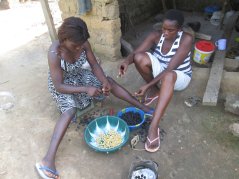Blogpost
Ensuring survival of non-timber forest products
Fresh from the forests and markets of central Africa, recent PhD graduate Louis Ndumbe, supervised by FNP’s Verina Ingram, provides a glimpse into his doctoral research findings.

The Central African tropical humid forest covers 280 million ha and is the largest of its kind in the world after the Amazon. Cameroon's humid forest zone contains some of Africa's most diverse ecosystems. In addition to their role in carbon sequestration and the fight against climate change, the Congo Basin forest is also an important center of biological diversity, serving as a nursery and reservoir of genetic robustness, vitality and resilience. In a socio-economic context is characterized by low levels of development and a difficult business environment, with about 61% of the population living on less than $2 per day and about 46% population living in/near forests, non-timber forest products (NTFPs) have medicinal, cultural, environmental and socio-economic benefits for both forest, rural and urban populations. For example, Garcinia cola nuts and Cola acuminata nuts are harvested and sold, and customarily served with palm wine (from the oil palm Elaeis guineensis and raffia palm (Raphia spp.) in rituals and ceremonies. The role NTFPs play in contributing to livelihoods of to rural and urban populations has been confirmed, particularly how it can economically empower women.
One overlooked NTFP is a high value seed kernel locally known as njansang (Ricinodendron heudelotii). Based on interviews with 261 harvesters, retailers, exporters, traders and processing enterprises, the seed has been found to play an important role in diversifying the income of people engaged in the value chain, who are mostly women. However, over-exploitation, large-scale conversion of forest into agricultural land and forest degradation pose a threat to both the tree and the incomes gained from its trade. This species and its trade are not addressed in national and regional forest, agricultural or trade policies or laws. The regulatory, institutional and policy framework for NTFPs generally has been criticized as being inconsistent and largely ineffective in ensuring sustainable trade. Plural governance arrangements including customary, voluntary and market-based schemes, rules introduced by projects and programs and international standards are lead to conflicting governance regimes that negatively affects the sustainability of species, such as njansang, upon which value chains are based on. As data on the status, level of threat, volumes and values of many NTFPs, including njansang, are lacking or insufficient to provide a solid base for decision making at the national and regional levels, this work is important in adding to the evidence base. This, according to researchers and practitioners, is sorely needed to inform policymakers and development interventions in the forest sector in the Congo Basin. Lessons learnt from the study of this NTFP indicate that long-term sustainability of the value chain could be improved by increasing collaboration between stakeholders, collective action, disseminating knowledge about processing and storage techniques, and promoting domestication and cultivation to ensure that the critical cultural, environmental and socio-economic life support values provide by NTFPs continues in the long term.
